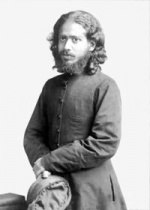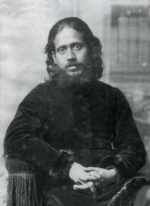Mohini Mohun Chatterji: Difference between revisions
Pablo Sender (talk | contribs) No edit summary |
Pablo Sender (talk | contribs) No edit summary |
||
| Line 8: | Line 8: | ||
== Theosophical Society involvement == | == Theosophical Society involvement == | ||
[[File:Mohini Mohun Chatterji 2.jpg|right|150px]] | [[File:Mohini Mohun Chatterji 2.jpg|right|150px]] | ||
Mohini became a member of the Bengal Theosophical Society on April 16, 1882. According to [[Readers Guide to The Mahatma Letters to A. P. Sinnett (book)|''Readers Guide to The Mahatma Letters to A. P. Sinnett'']], "When HSO opened the first Theosophical Sunday School in Calcutta on [[March 10]], 1883, with 17 boys, Mohini was appointed their teacher | Mohini became a member of the Bengal Theosophical Society on [[April 16]], 1882. According to [[Readers Guide to The Mahatma Letters to A. P. Sinnett (book)|''Readers Guide to The Mahatma Letters to A. P. Sinnett'']], "When [[Henry Steel Olcott|HSO]] opened the first Theosophical Sunday School in Calcutta on [[March 10]], 1883, with 17 boys, Mohini was appointed their teacher".<ref>George E. Linton and Virginia Hanson, eds., ''Readers Guide to The Mahatma Letters to A. P. Sinnett'' (Adyar, Chennai, India: Theosophical Publishing House, 1972), 223.</ref> | ||
He gave evidence to the [[Society for Psychical Research]] concerning the reality of psychic phenomena at Adyar,<ref>”Chatterji, Mohini Mohun,” ''The Theosophical Year Book, 1938'' (Adyar, Madras, India: The Theosophical Publishing House, 1938), 172.</ref> in what came to be known as the [[Hodgson Report|Hodgson investigation]]. | He gave evidence to the [[Society for Psychical Research]] concerning the reality of psychic phenomena at Adyar,<ref>”Chatterji, Mohini Mohun,” ''The Theosophical Year Book, 1938'' (Adyar, Madras, India: The Theosophical Publishing House, 1938), 172.</ref> in what came to be known as the [[Hodgson Report|Hodgson investigation]]. | ||
== Mohini and | He worked as private secretary to H. S. Olcott and accompanied him and [[Helena Petrovna Blavatsky|Mme. Blavatsky]] on their European tour in 1884: | ||
<blockquote>The purpose of his trip to Europe was seemingly to give the members there some assistance in understanding the Eastern doctrines which had been brought into prominence by [[Alfred Percy Sinnett|APS]] in his book [[Esoteric Buddhism (book)|''Esoteric Buddhism'']]."<ref>George E. Linton and Virginia Hanson, eds., ''Readers Guide to The Mahatma Letters to A. P. Sinnett'' (Adyar, Chennai, India: Theosophical Publishing House, 1972), 223.</ref></blockquote> | |||
However, in March 1886 Mme. Blavatsky wrote to Mr. Sinnett: | |||
<blockquote>Mohini was sent, and at first won the hearts and poured new life into the L.L. He was spoiled by male and female adulation, by incessant flattery and his own weakness — your reserve and pride left you passive when you ought to have been active.<ref>Vicente Hao Chin, Jr., ''The Mahatma Letters to A.P. Sinnett in chronological sequence'' No. 140 (Quezon City: Theosophical Publishing House, 1993), 459.</ref></blockquote> | |||
Mohini resigned from the [[Theosophical Society]] in 1887 and went back to his former home in Calcutta, where he resumed his practice of law. | |||
== Mohini and Master K.H. == | |||
Mohini was present in London in 1884 when the young German artist [[Hermann Schmiechen]] painted portraits of the Mahatmas. He was described by [[Laura Holloway-Langford|Laura C. Holloway]] as being “nearer the Master than all others in the room, not even excepting H. P. B.”<ref> Laura C. Holloway, “The Mahatmas and Their Instruments Part II,” ''The Word'' (New York), July 1912, pp. 200-206, available at The Blavatsky Archives [http://www.blavatskyarchives.com/holloway2.htm#The Portraits of the Mahatmas]</ref> He and Mrs. Holloway wrote ''Man: Fragments of a Forgotten History'', which was published in 1887 under the pseudonym [[Two Chelâs|"Two Chelâs"]].<ref>Two Chelas, ''Man: Fragments of a Forgotten History'', 1887. The complete text is available at [http://www.theosophical.ca/books/ManFragmentsOfAForgottenHistory_MChatterjiLCHolloway.pdf]</ref>. | Mohini was present in London in 1884 when the young German artist [[Hermann Schmiechen]] painted portraits of the Mahatmas. He was described by [[Laura Holloway-Langford|Laura C. Holloway]] as being “nearer the Master than all others in the room, not even excepting H. P. B.”<ref> Laura C. Holloway, “The Mahatmas and Their Instruments Part II,” ''The Word'' (New York), July 1912, pp. 200-206, available at The Blavatsky Archives [http://www.blavatskyarchives.com/holloway2.htm#The Portraits of the Mahatmas]</ref> He and Mrs. Holloway wrote ''Man: Fragments of a Forgotten History'', which was published in 1887 under the pseudonym [[Two Chelâs|"Two Chelâs"]].<ref>Two Chelas, ''Man: Fragments of a Forgotten History'', 1887. The complete text is available at [http://www.theosophical.ca/books/ManFragmentsOfAForgottenHistory_MChatterjiLCHolloway.pdf]</ref>. | ||
| Line 30: | Line 39: | ||
Mohini died in February, 1936. | Mohini died in February, 1936. | ||
== Online resources == | |||
===Articles=== | |||
*[http://theosophy.ph/encyclo/index.php?title=Chatterji,_Mohini_Mohun# Mohini Mohun Chatterji] at Theosopedia. | |||
*[https://www.google.com/url?sa=t&rct=j&q=&esrc=s&source=web&cd=1&cad=rja&ved=0CDMQFjAA&url=http%3A%2F%2Fwww.shodh.net%2Findex.php%3Foption%3Dcom_phocadownload%26view%3Dcategory%26download%3D138%3A4-mohini-mohan-chatterjis-influence-on-wb-yeats-dr-suman-singh-%26id%3D40%3Avol3-issue-2%26Itemid%3D99&ei=xItxUcPuFaqM2gWDvoG4Dw&usg=AFQjCNFvvU4HuEEFi-iOiI7PXdtGR-uF4Q&bvm=bv.45373924,d.b2I# Mohini Mohan Chatterji's Influence on W.B. Yeats] by Dr. Suman Singh | |||
== Additional resources == | == Additional resources == | ||
Revision as of 18:57, 19 April 2013
Mohini Mohun Chatterji was a Bengali attorney and scholar. He became a chela of the the Mahâtma Koot Hoomi, but ultimately failed as a chela, and resigned from the Theosophical Society in 1887, after only five years of membership.
Early life and education
Mr. Chatterji, usually known as Mohini, was born in 1858 into a Brahmin family, descended from Hindu reformer Ram Roy.[1] He attended university in Calcutta, and was awarded Bachelor of Laws and Master of Arts degrees. His wife was the niece of Bengali poet Rabindranath Tagore.[2]
Theosophical Society involvement
Mohini became a member of the Bengal Theosophical Society on April 16, 1882. According to Readers Guide to The Mahatma Letters to A. P. Sinnett, "When HSO opened the first Theosophical Sunday School in Calcutta on March 10, 1883, with 17 boys, Mohini was appointed their teacher".[3]
He gave evidence to the Society for Psychical Research concerning the reality of psychic phenomena at Adyar,[4] in what came to be known as the Hodgson investigation.
He worked as private secretary to H. S. Olcott and accompanied him and Mme. Blavatsky on their European tour in 1884:
The purpose of his trip to Europe was seemingly to give the members there some assistance in understanding the Eastern doctrines which had been brought into prominence by APS in his book Esoteric Buddhism."[5]
However, in March 1886 Mme. Blavatsky wrote to Mr. Sinnett:
Mohini was sent, and at first won the hearts and poured new life into the L.L. He was spoiled by male and female adulation, by incessant flattery and his own weakness — your reserve and pride left you passive when you ought to have been active.[6]
Mohini resigned from the Theosophical Society in 1887 and went back to his former home in Calcutta, where he resumed his practice of law.
Mohini and Master K.H.
Mohini was present in London in 1884 when the young German artist Hermann Schmiechen painted portraits of the Mahatmas. He was described by Laura C. Holloway as being “nearer the Master than all others in the room, not even excepting H. P. B.”[7] He and Mrs. Holloway wrote Man: Fragments of a Forgotten History, which was published in 1887 under the pseudonym "Two Chelâs".[8].
Writings
Mohini wrote poetry and prose in both English and his native Bengali. He translated the The Crest-Jewel of Wisdom of Sankaracharya. He worked with G. R. S. Mead in translating the Upanishads in 1896, using the pseudonym J. C. Chattopadhyaya.[9]
Irish poets Æ and W. B. Yeats were acquainted with Mohini, and he was said to have influenced the oriental turn to their writings.
Additional writings:
- Viveka-Cūḍāmaṇi. Adyar, Madras: Theosophical Publishing House, 1968. Translator.
Later years
Mohini died in February, 1936.
Online resources
Articles
- Mohini Mohun Chatterji at Theosopedia.
- Mohini Mohan Chatterji's Influence on W.B. Yeats by Dr. Suman Singh
Additional resources
See also references in:
- The Mahatma Letters to A. P. Sinnett
- A Short History of the Theosophical Society
- Letters of H. P. Blavatsky to A. P. Sinnett
Notes
- ↑ George E. Linton and Virginia Hanson, eds., Readers Guide to The Mahatma Letters to A. P. Sinnett (Adyar, Chennai, India: Theosophical Publishing House, 1972), 223.
- ↑ ”Chatterji, Mohini Mohun,” The Theosophical Year Book, 1938 (Adyar, Madras, India: The Theosophical Publishing House, 1938), 172.
- ↑ George E. Linton and Virginia Hanson, eds., Readers Guide to The Mahatma Letters to A. P. Sinnett (Adyar, Chennai, India: Theosophical Publishing House, 1972), 223.
- ↑ ”Chatterji, Mohini Mohun,” The Theosophical Year Book, 1938 (Adyar, Madras, India: The Theosophical Publishing House, 1938), 172.
- ↑ George E. Linton and Virginia Hanson, eds., Readers Guide to The Mahatma Letters to A. P. Sinnett (Adyar, Chennai, India: Theosophical Publishing House, 1972), 223.
- ↑ Vicente Hao Chin, Jr., The Mahatma Letters to A.P. Sinnett in chronological sequence No. 140 (Quezon City: Theosophical Publishing House, 1993), 459.
- ↑ Laura C. Holloway, “The Mahatmas and Their Instruments Part II,” The Word (New York), July 1912, pp. 200-206, available at The Blavatsky Archives Portraits of the Mahatmas
- ↑ Two Chelas, Man: Fragments of a Forgotten History, 1887. The complete text is available at [1]
- ↑ ”Chatterji, Mohini Mohun,” The Theosophical Year Book, 1938 (Adyar, Madras, India: The Theosophical Publishing House, 1938), 172.

